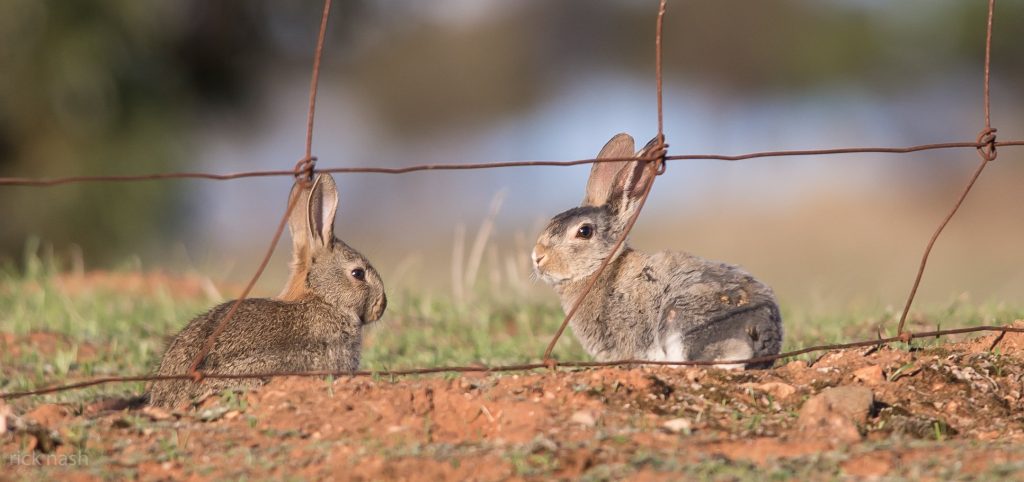
European rabbits (Oryctolagus cuniculus) are declared pests in Western Australia as designated under the Biosecurity and Agriculture Management Act 2007. As such, landholders are required to control rabbits on their properties. Even landholders not actively using their property are still legally obliged to control rabbits to protect their neighbours’ land from the impact of rabbits.
Read about LBG’s annual Calicivirus RHDV1-K5 summer program: Calicivirus RHDV1-K5, one tool in an integrated approach for effective rabbit control
RABBITS CAUSE SIGNIFICANT IMPACT TO OUR ENVIRONMENT, ECONOMY AND MORE
European rabbits are one of Australia’s most costly and environmentally damaging pests. They are pests because they compete with livestock and native animals for pasture and food, damage crops and native vegetation, and cause erosion. Rabbits are a serious threat to both agriculture and native biodiversity. They cause an estimated $197 million in agricultural losses annually and threaten over 320 native species, including the Malleefowl, Orange-bellied Parrot, and various endangered wallabies and orchids. Rabbits damage crops and vegetation cover, out-compete native species, alter ecological communities, contribute to soil erosion, and remove critical habitat for native animals. In urban and peri-urban areas, rabbits can also damage gardens, sportsgrounds, cemeteries, and culturally significant sites.
Leschenault Biosecurity Group (LBG) can assist landholders with development of an integrated management approach to rabbit control using variety of control methods and tools. Contact us to discuss what is best for you and your property.
RABBITS CAUSE SIGNIFICANT IMPACT TO OUR ENVIRONMENT, ECONOMY AND MORE:
• compete with native animals for food & shelter
• destroy crops, pastures, revegetation, etc
• damage gardens, sportsgrounds & parkland reserves
• undermine verandas, garages, sheds & more
• maintain fox & feral cat populations
• have contributed to the extinction of several small (up to 5.5 kilograms) ground-dwelling mammals
• costs an estimated $250 million annually worth of damage to Australian Agriculture
Persistence is the key to effective rabbit management. One-off efforts produce only short-term results as rabbits may produce many offspring and populations can recover quickly even after successful control programs. Maximum effectiveness is achieved by integrating appropriate control methods. Best control is achieved in late summer when rabbit numbers are decreasing, and feed is limited. District-wide campaigns can reduce the problem of re-infestation by covering a large area.
EFFECTIVE CONTROL REQUIRES PERSISTENCE AND INTEGRATION OF MULTIPLE CONTROL METHODS
To optimise control of feral rabbits, a combination of control tools and methods, such as targeted releases of Calicivirus RHDV1-K5, strategic fencing and tree protection, harbourage reduction, cleaning rubble and wood piles that may be used as refuge and tree protection are advised. We approach rabbit management with the integrated use of a variety of tools and strategies, including with cooperation and assistance of participating landholders within our operational area, targeted releases of the Calicivirus RHDV1 K5 (the “K5″ strain of the Rabbit Haemorrhagic Disease Virus (RHDV).
LBG can assist with:
• rabbit control advice specific to your property
• Calicivirus RHDV1 K5 releases during area-wide summer program
• loan of surveillance cameras, traps and smokers for investigations of warrens and burrows
Please contact us to discuss rabbit control strategies for YOUR property, including:
• Biological Control _ Calicivirus RHDV1 K5 Release Program (conducted during summer months)
• Harbourage reduction
• Exclusion fencing
• Warren ripping
• Baiting* and trapping
• Other as may be applicable to your property
Best practice methods for controlling rabbits can vary. CONTACT LBG for personalised advice specific to your property be e-mail at info@lbginc.org.au or ring us on 0477 049 967.
* Before commencing any baiting program, be aware of off-target risks and strictly adhere to guidance specific to each product. For information on bait, poison and toxin (bait) products available for use in WA relevant to rabbits, please visit the following link: DPIRD_Rabbit control: bait products
Below is a list of resources to help manage feral rabbits:
- PestSmart Toolkit: Practical guides and factsheets for planning and managing rabbit control.
- RabbitScan: A free, easy-to-use tool for recording rabbit sightings, damage, and control efforts.
- Glovebox Guide for Managing Rabbits: Covers rabbit biology, damage, control tools, and legislation.

Recent Comments